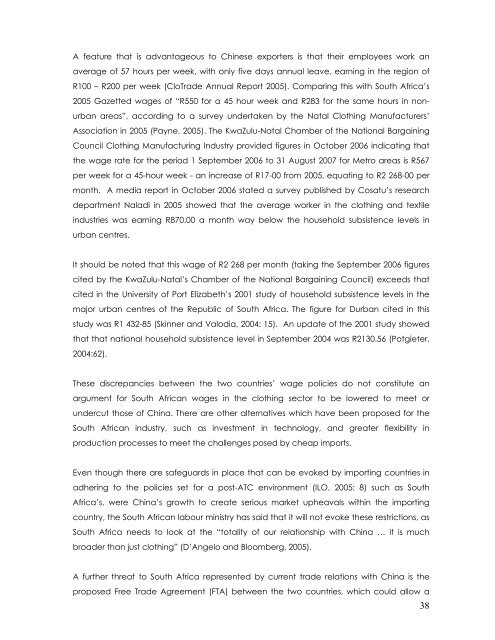You also want an ePaper? Increase the reach of your titles
YUMPU automatically turns print PDFs into web optimized ePapers that Google loves.
A feature that is advantageous to Chinese exporters is that their employees work an<br />
average of 57 hours per week, with only five days annual leave, earning in the region of<br />
R100 – R200 per week (CloTrade Annual Report 2005). Comparing this with South Africa’s<br />
2005 Gazetted wages of “R550 for a 45 hour week and R283 for the same hours in non-<br />
urban areas”, according to a survey undertaken by the Natal Clothing Manufacturers’<br />
Association in 2005 (Payne, 2005). The KwaZulu-Natal Chamber of the National Bargaining<br />
Council Clothing Manufacturing Industry provided figures in October 2006 indicating that<br />
the wage rate for the period 1 September 2006 to 31 August 2007 for Metro areas is R567<br />
per week for a 45-hour week - an increase of R17-00 from 2005, equating to R2 268-00 per<br />
month. A media <strong>report</strong> in October 2006 stated a survey published by Cosatu’s research<br />
department Naladi in 2005 showed that the average worker in the clothing and textile<br />
industries was earning R870.00 a month way below the household subsistence levels in<br />
urban centres.<br />
It should be noted that this wage of R2 268 per month (taking the September 2006 figures<br />
cited by the KwaZulu-Natal’s Chamber of the National Bargaining Council) exceeds that<br />
cited in the University of Port Elizabeth’s 2001 study of household subsistence levels in the<br />
major urban centres of the Republic of South Africa. The figure for Durban cited in this<br />
study was R1 432-85 (Skinner and Valodia, 2004: 15). An update of the 2001 study showed<br />
that that national household subsistence level in September 2004 was R2130.56 (Potgieter,<br />
2004:62).<br />
These discrepancies between the two countries’ wage policies do not constitute an<br />
argument for South African wages in the clothing sector to be lowered to meet or<br />
undercut those of China. There are other alternatives which have been proposed for the<br />
South African industry, such as investment in technology, and greater flexibility in<br />
production processes to meet the challenges posed by cheap imports.<br />
Even though there are safeguards in place that can be evoked by importing countries in<br />
adhering to the policies set for a post-ATC environment (ILO, 2005: 8) such as South<br />
Africa’s, were China’s growth to create serious market upheavals within the importing<br />
country, the South African labour ministry has said that it will not evoke these restrictions, as<br />
South Africa needs to look at the “totality of our relationship with China … it is much<br />
broader than just clothing” (D’Angelo and Bloomberg, 2005).<br />
A further threat to South Africa represented by current trade relations with China is the<br />
proposed Free Trade Agreement (FTA) between the two countries, which could allow a<br />
38
















